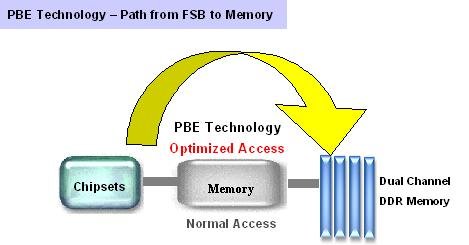AOpen AX4SG Max - Benchmarks with and without PBE
Page: 1/2Note: This article was originally published in 2003.
Soon we will have a review of the AOpen AX4SG Max motherboard which is based on the Intel Springdale chipset. Today however we will be taking a look at the Performance Boosting Engine (PBE ) function from AOpen which is added in the new BIOS for this motherboard. The Performance Boosting Engine is similar to Intel's Performance Acceleration Technology (PAT) which is for the Canterwood chipsets only.
Some motherboard makers like Asus, Abit, and AOpen however, have found a way to do the same kind of trick on the Intel Springdale chipset (Intels PAT was only intended for the Canterwoord chipsets). Intel's PAT was one of the only things that made a 'major' performance difference between the Springdale and Canterwood chipsets, now let's see how the AOpen AX4SG Max scores with PBE enabled and disabled in some various benchmarks! To enable the Performance Boosting Engine you will need to update the BIOS version of the AOpen AX4SG Max motherboard to version 1.01.


What is PBE Technology? (from AOpen website)
Acting as similar as PAT in uplifting the system performance, PBE enables users to optimize the accessing speed and quality between the CPU and Memory to 3% or 5%. Theoretically speaking, the CPU must go through some standard paths to access memory. However, with an optimized path created, the CPU may access memory in a faster way without going through standard paths. Therefore, PBE effectively shortened the distance between CPU and memory and thus increasing system performance as a matter of fact. And what makes PBE an excellent function of all is that it applies on all 865 series motherboard

By default, PBE is disabled, why you are asking? Read this warning from AOpen : Enabling this feature will make maximum use of your RAM modules. This is not the standard specification of Intel 865G/865PE chipset. Uneven quality RAM modules in the market may not able to withstand this kind of extreme usage and cause the instability of your system. You are taking your own risk for taking advantage of this benefit.
Test system
Intel Pentium 4 2.8C (800MHz FSB)
AOpen AX4SG Max motherboard (Springdale 865G chipset)
2x Corsair XMS3500C2 256MB RAM (running at DDR400 @ 2-6-3-3)
MSI GeForce 4 Ti4200 with 128MB RAM 3D Card
Maxtor 120GB SATA Hard Disk (6Y120M0)
Antec 550W TrueControl PSU
OS : Windows XP with SP1
Application Benchmarks
First we check out some application benchmarks, we start with the SiSoftware Sandra 2003 Benchmark suite :

This was the first test, especially the Dhrystone ALU score differs a lot, almost 2%. The Whetstone FPU only a little and the iSSE2 shows around 0.5% performance increase.

The CPU Multimedia benchmark also shows a small, but nice performance increase, float is a lot more used so this performance increasement of 0.83% will surely do your system some good.

The Memory Bandwidth benchmarks shows us in both cases a bandwidth increases from 105MB/s(2.3% more) in Integer Buffered, to 137MB/s (3% more) more in the Float Buffered benchmark
PiFast 4.2
After this we calculated 9 999 999 digits of Pi with PiFast 4.2 :

The Performance Boosting Engine shows a performance increase of 0.61 seconds in this case.
WinRAR

We Rarred 100MB of data with WinRAR, in this case PBE shows us a performance increase of 1 second.
PCMark2002

And as last application benchmark we have the PCMark2002 benchmark. Especially the CPU score increased a lot, with 4%, the HDD score only a little and the Memory score with almost 1.2%
Head over the the next page for the Game benchmarks

[ Back to Articles ]
Loading Comments